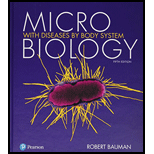
Concept explainers
(1)
To determine:
How Jason and Julie possibly got infected, why CA-MRSA is considered as an evolving disease, given that MRSA has been around for years, and why the map does not display more countries in South America and Africa with cases of CA-MRSA.
Case summary:
Julie was surprised and feels very proud that her boyfriend bought her a tattoo as an 18th birthday gift. After a week, Julie and Jason are affected by an evolving disease, which is referred to as community-associated, methicillin-resistant Staphylococcus aureus (CA-MRSA) diseases. Julie’s leg and arm are layered with swollen, red, and painful lesions (containing pus); soon, she developed fever. Jason misunderstood that he suffered a spider bite (Wednesday). On the next day, he is unable to walk, and he noticed a red-color line going up from his ankle to his groin. Soon, his health condition became worse and he was hospitalized for 10 days.
He was severely affected by bacteremia (blood) and osteomyelitis (his bones are affected). For many years, the health center workers fought to control healthcare-associated MRSA (HA-MRSA). Usually, the HA-MRSA infects hospitalized patients, but in recent years, common people (other than hospitalized patients) are also affected; for example, risky tattooists, school students, and athletes. It is spread by sharing clothes, fomites, razors, and towels.
Julie is suggested oral antimicrobials such as doxycycline, trimethoprim-sulfamethoxazole, and clindamycin) and she was given vancomycin (intravenous).
(2)
To determine:
Why CA-MRSA is considered as an evolving disease, given that MRSA has been around for years.
Case summary:
Julie was surprised and feels very proud that her boyfriend bought her a tattoo as an 18th birthday gift. After a week, Julie and Jason are affected by an evolving disease, which is referred to as community-associated, methicillin-resistant Staphylococcus aureus (CA-MRSA) diseases. Julie’s leg and arm are layered with swollen, red, and painful lesions (containing pus); soon, she developed a fever. Jason misunderstood that he suffered a spider bite (Wednesday). On the next day, he is unable to walk, and he noticed a red-color line going up from his ankle to his groin. Soon, his health condition became worse and he was hospitalized for 10 days.
He was severely affected by bacteremia (blood) and osteomyelitis (his bones were affected). For many years, the health center workers fought to control the healthcare-associated MRSA (HA-MRSA). Usually, the HA-MRSA infects hospitalized patients, but in recent years, common people (other than hospitalized patients) are also affected; for example, risky tattooists, school students, and athletes. It is spread by sharing clothes, fomites, razors, and towels.
Julie is suggested oral antimicrobials such as doxycycline, trimethoprim-sulfamethoxazole, and clindamycin) and she is given vancomycin (intravenous).
(3)
To determine:
Why the map does not display more countries in South America and Africa with cases of CA-MRSA.
Case summary:
Julie was surprised and feels very proud that her boyfriend bought her a tattoo as an 18th birthday gift. After a week, Julie and Jason are affected by an evolving disease, which is referred to as community-associated, methicillin-resistant Staphylococcus aureus (CA-MRSA) diseases. Julie’s leg and arm are layered with swollen, red, and painful lesions (containing pus); soon, she developed a fever. Jason misunderstood that he suffered a spider bite (Wednesday). On the next day, he is unable to walk and he noticed a red-color line going up from his ankle to his groin. Soon, his health condition became worse and he was hospitalized for 10 days.
He was severely affected by bacteremia (blood) and osteomyelitis (his bones are affected). For many years, the health center workers fought to control the healthcare-associated MRSA (HA-MRSA). Usually, HA-MRSA infects hospitalized patients, but in recent years, common people (other than hospitalized patients) are also affected; for example, risky tattooists, school students, and athletes. It is spread by sharing clothes, fomites, razors, and towels.
Julie is suggested oral antimicrobials such as doxycycline, trimethoprim-sulfamethoxazole, and clindamycin) and she is given vancomycin (intravenous).
Want to see the full answer?
Check out a sample textbook solution
Chapter 10 Solutions
Microbiology with Diseases by Body System (5th Edition)
- 22. Which of the following mutant proteins is expected to have a dominant negative effect when over- expressed in normal cells? a. mutant PI3-kinase that lacks the SH2 domain but retains the kinase function b. mutant Grb2 protein that cannot bind to RTK c. mutant RTK that lacks the extracellular domain d. mutant PDK that has the PH domain but lost the kinase function e. all of the abovearrow_forwardWhat is the label ?arrow_forwardCan you described the image? Can you explain the question as well their answer and how to get to an answer to an problem like this?arrow_forward
- Describe the principle of homeostasis.arrow_forwardExplain how the hormones of the glands listed below travel around the body to target organs and tissues : Pituitary gland Hypothalamus Thyroid Parathyroid Adrenal Pineal Pancreas(islets of langerhans) Gonads (testes and ovaries) Placentaarrow_forwardWhat are the functions of the hormones produced in the glands listed below: Pituitary gland Hypothalamus Thyroid Parathyroid Adrenal Pineal Pancreas(islets of langerhans) Gonads (testes and ovaries) Placentaarrow_forward
- Essentials of Pharmacology for Health ProfessionsNursingISBN:9781305441620Author:WOODROWPublisher:CengageLifetime Physical Fitness & WellnessHealth & NutritionISBN:9781337677509Author:HOEGERPublisher:Cengage





